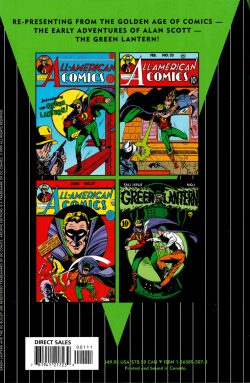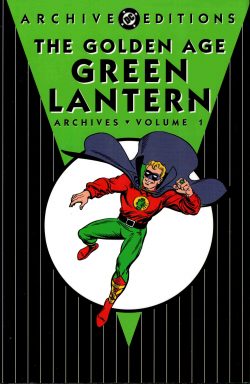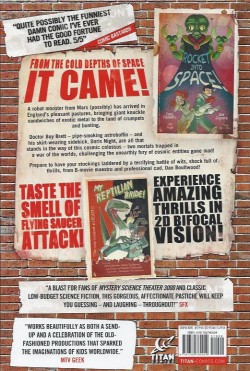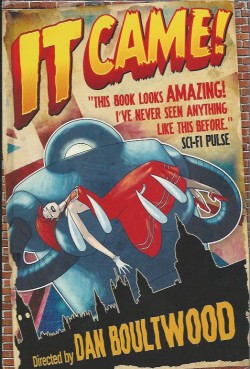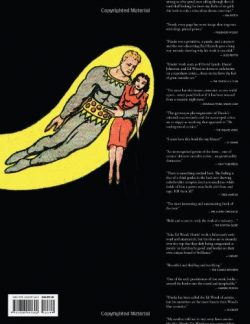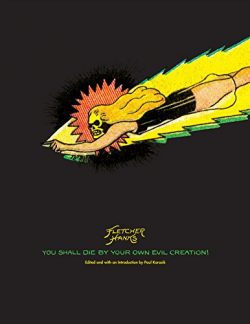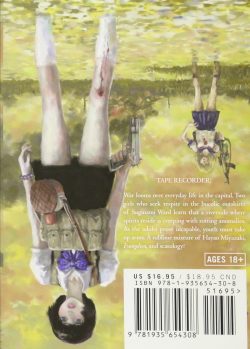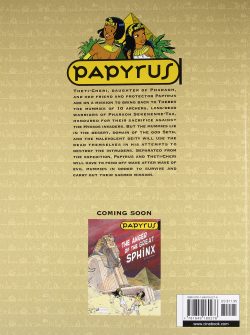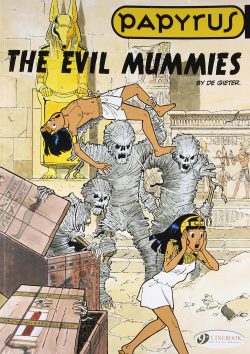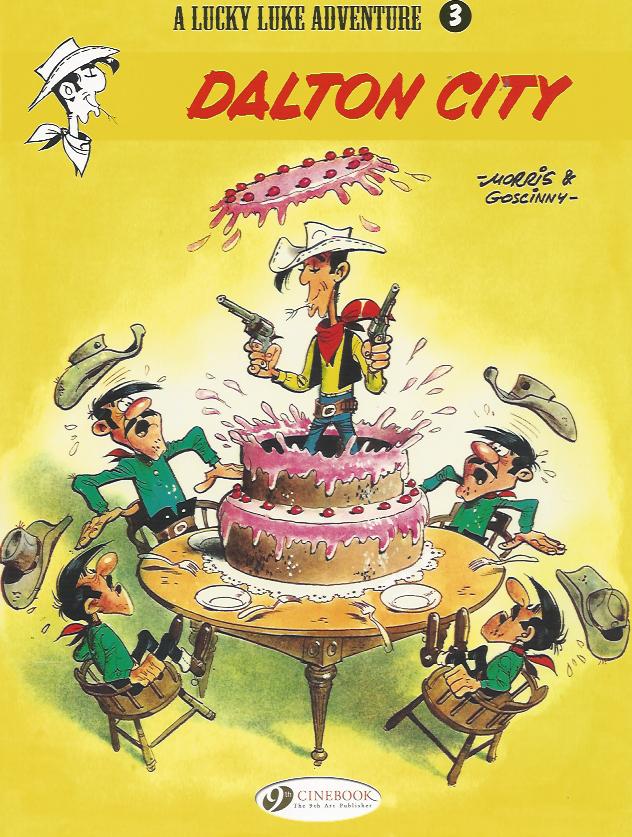
By Morris & Goscinny, translated by Frederick W. Nolan (CineBook)
ISBN: 978-1-905460-13-7 (Album PB)
Lucky Luke is a rangy, good-natured, lightning-fast cowboy who roams the fabulously mythic Old West, having light-hearted adventures with his horse Jolly Jumper and interacting with a host of historical and legendary figures of the genre.
His continued exploits over nearly seventy years have made him one of the best-selling comic characters in Europe (81 collected books and more than 300 million albums in 30 languages thus far), with spin-off toys, computer games, animated cartoons and even a plethora of TV shows and live-action movies.
He was created in 1946 by Belgian animator, illustrator and cartoonist Maurice de Bévère (“Morrisâ€) for the 1947 Annual (L’Almanach Spirou 1947) of Le Journal de Spirou, before launching into his first weekly adventure ‘Arizona 1880′ on December 7th 1946.
Prior to that, while working at the CBA (Compagnie Belge d’Actualitiés) cartoon studio, Morris met future comics super-stars Franquin and Peyo, and worked for weekly magazine Le Moustique as a caricaturist – which is probably why (to my eyes at least) his lone star hero looks uncannily like the young Robert Mitchum who graced so many memorable mid-1940s B-movie Westerns.
Morris quickly became one of “la Bande des quatre†– The Gang of Four – which comprised creators Jijé, Will and his old comrade Franquin: the leading proponents of the loose and free-wheeling artistic style known as the “Marcinelle School†which dominated Spirou in aesthetic contention with the “Ligne Claire†style used by Hergé, EP Jacobs and other artists in Le Journal de Tintin.
In 1948 said Gang (all but Will) visited America, meeting US creators and sightseeing. Morris stayed for six years, meeting fellow traveller René Goscinny, scoring some work from newly-formed EC sensation Mad and making copious notes and sketches of the swiftly vanishing Old West.
That research would resonate on every page of his life’s work.
Working solo until 1955, Morris produced another nine albums worth of affectionate sagebrush parody before reuniting with Goscinny, who became the regular wordsmith as Luke attained the dizzying heights of superstardom, commencing with ‘Des rails sur la Prairie’ (Rails on the Prairie), which began in Spirou on August 25th 1955.
In 1967 the six-gun straight-shooter switched teams, transferring to Goscinny’s own magazine Pilote with ‘La Diligence’ (The Stagecoach). Goscinny produced 45 albums with Morris before his death, from whence Morris continued both singly and with fresh collaborators.
Morris died in 2001 having drawn fully 70 adventures, plus the spin-off adventures of Rantanplan (“dumbest dog in the West†and a charming spoof of cinema canine Rin-Tin-Tin), with Achdé, Laurent Gerra, Benacquista & Pennac taking over the franchise, producing another five tales to date.
Moreover, apart from that very first adventure, Lucky (to appropriate a quote applied to the thematically simpatico Alias Smith and Jones) “in all that time… never shot or killed anyoneâ€â€¦
Lucky Luke first appeared in Britain syndicated to weekly comic Film Fun and again in 1967 in Giggle where he was renamed Buck Bingo. In all these venues – as well as the numerous attempts to follow the English-language successes of Tintin and Asterix albums from Brockhampton and Knight Books – Luke had a trademark cigarette hanging insouciantly from his lip, but in 1983 Morris, no doubt amidst both pained howls and muted mutterings of “political correctness gone madâ€, substituted a piece of straw for the much-travelled dog-end, which garnered him an official tip of the hat from the World Health Organization.
The most recent attempt to bring Lucky Luke to our shores and shelves comes from Cinebook (who have rightly restored the foul weed to his lips on the interior pages if not the covers…) and Dalton City was the third of 76 albums (and counting), available both on paper and as e-book editions.
It was the 34th comic cowboy chronicle and Goscinny’s 25th collaboration with Morris, originally appearing in 1969 and featuring the first appearance of that most stupid of do-gooding doggy sidekicks Rantanplan. You have been warned…
The saga commences in Fenton Town, a city of utter depravity and villainy run by and for crooks, badmen and owlhoots by the cunning mastermind Dean Fenton; a mean man with the unsavoury hobby of collecting Sheriff’s stars… from their bullet-riddled bodies…
The night a lean, laconic lone rider ambled into town the murderous gambler’s fortunes changed forever, and when Luke spectacularly delivered the gang boss to justice, Fenton got 1223 years hard labour at Texas penitentiary, an imposing edifice already crammed with dozens of other varmints who failed to take Lucky Luke seriously.
And that’s where the trouble really starts…
Amongst the inmates are stupid sandbagging scallywags Averell, Jack and William Dalton and their smart, psychotic, bossy and short brother Joe, who had made things hot for our hero in the past. As they all crack rocks together the Dalton Gang are particularly influenced by Fenton’s tales of his little kingdom.
Contentedly ambling away from the prison, Luke and Jolly Jumper have no idea that an idiotic, incompetent telegraph operator is about to make their lives impossibly difficult. Handed a mis-transcribed message from the Governor to free inmate Joe Milton for Good Behaviour, the baffled Warden forcibly ejects the furiously insulted Dalton head honcho. Eventually calming down – at least as much as Joe Dalton ever can – the wily skunk promptly blows up an outer wall to liberate his scurrilous simpleton siblings and they all make tracks for the now-deserted Fenton Town.
Search parties of course trail them, but when vain, friendly and exceedingly dim prison hound Rin Tin Can absently-mindedly forgets himself and joins his quarry, the shame-faced guards have to return empty-handed…
Regretfully, the Warden sends a telegram to Lucky Luke – again appallingly garbled – and the normally unflappable gunhawk is less than amused. It takes the pleadings of the Governor of Texas himself to convince him to go after his old enemies…
In the renamed Dalton City, Joe and the boys have big plans. They’re going to operate a Mecca for all the criminals in the state: a safe place for badmen to hide and spend their stolen loot. Joe will be in charge, Jack will operate the hotel, William the stables and Averell will run the restaurant. He even has faithful, omnivorous Rin Tin Can to test all his recipes on…
After much unlikely and unfamiliar hard work the place is starting to come together when they get an even bigger boost by capturing their nemesis Lucky Luke spying on them. The hero had forgotten how stupid Rin Tin Can could be…
The hapless prisoner is then put to work testing their wares: surely if the service is good enough for Luke it will be perfect for the scum of the West? However the boys make the foolish mistake of listening to his suggestions for improvement…
The beginning of the end comes when Joe writes off to hire a singer and troupe of dancing girls. When the bombastic virago Lulu Breechloader and her associates Belle, Sugar Linda and Pearl arrive Lucky has all he needs to drive an amorous wedge into the solidarity of the felonious fellowship and, as an army of bandits and killers steadily roll into town looking for sanctuary and entertainment, they are invited to the wedding of the century…
The only persons unaware of the impending – and hard-fought for – nuptials of Joe Dalton and Lulu are the bride herself and her blithely unaware piano-playing husband…
In the ensuing chaos and explosive gunplay it isn’t hard for a smart cowboy crusader to make the biggest capture of wanted criminals in Texas’ history and ride off into the sunset with a new four-footed canine companion…
Once again the masterful wit and wicked deviousness of the indomitable hero triumphs in a splendidly intoxicating blend of all-ages action, seductive slapstick and wry cynical humour.
This grand old hoot sits in the tradition of Destry Rides again and Support Your Local Sheriff (or perhaps Paint Your Wagon, Evil Roy Slade or Cat Ballou are more your style?), superbly executed by master storytellers, and a wonderful introduction to a unique genre for modern kids who might well have missed the romantic allure of the Wild West that never was…
And in case you’re worried, even though the interior art still has our hero chawin’ on that ol’ nicotine stick, trust me, there’s very little chance of anyone craving a quick snout, but quite a high probability that they’ll be addicted to Lucky Luke Albums…
© Dargaud Editeur Paris 1969 by Goscinny & Morris. © Lucky Comics. English translation © 2006 Cinebook Ltd.

